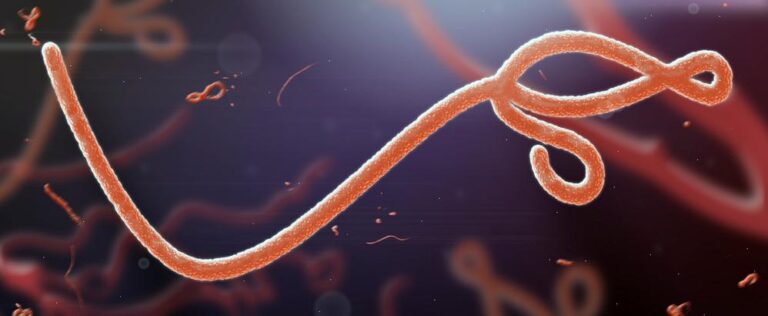The discovery is from one of a group of EU-funded projects whose work on infectious diseases could be used to tackle Ebola.While not a cure for the disease, the finding could clear the way to produce a new treatment for Ebola in the future. If scientists could work out how to halt the action of these proteins, they could help infected patients by reducing the severity of their symptoms and increasing their chances of survival.The discovery, made by researchers on the EU-funded ANTIGONE project, could also help scientists to develop treatments for other diseases that operate the same way.The ANTIGONE project looks at a number of different viruses and bacteria, including Ebola, to try and identify how and why these diseases occur. The researchers hope that if they are able to identify some common factors among different diseases they may be able to exploit this knowledge to reduce the risk of epidemics and help tackle outbreaks when they occur.Their research focuses on so-called zoonotic diseases, which are infectious diseases that travel from animals to humans. ANTIGONE is looking at how these diseases cross three key barriers, first from animals to humans, then within a single human body, and finally from human to human.“‘We do have a lot of expertise among our 14 institutes and it could be used to improve the situation for the current outbreak.’Professor Thijs Kuiken, ANTIGONE project coordinatorProfessor Thijs Kuiken, coordinator of the project, said: ‘Instead of being a project that concentrates on pathogens themselves, ANTIGONE concentrates on the general factors that allow pathogens to change host species, infect people and become easily transmissible among them.’Ebola belongs to a group of zoonotic viruses, known as filoviruses, that cause severe viral haemorrhagic fevers in humans and non-human primates. Its natural host is thought to be fruit bats.While Ebola probably isn’t particularly serious in its natural host, when it jumps the species barrier to humans – and non-human primates – it becomes extremely severe and has a very high mortality rate.Common factorsThe ANTIGONE research on Ebola is concentrating on how the disease crosses barriers within the human body and causes such serious effects in humans. It is looking at how the virus gains access to the appropriate tissue, replicates, deals with the human immune response, and is excreted from an infected person.Prof. Kuiken explained that Ebola is being used as a model pathogen for studying how filoviruses work within the human body. This means that results from the work on Ebola will be used to identify factors that could be relevant in other diseases.He said: ‘We call the pathogens we use model pathogens because, although we are interested in the pathogens, what we are really trying to do is find out if there are any general factors that can help explain why some pathogens do and other pathogens don’t switch hosts.’For example, researchers will now look to see if the soluble proteins produced by Ebola that damage blood vessel walls are present in other important filoviruses, such as Marburg virus, another ANTIGONE model pathogen. If so, it could lead to the development of an antiviral therapy that works against a number of filoviruses, not just Ebola.Conversely, as the number of deaths from the Ebola outbreak in West Africa exceeds 4 000, it is hoped that current research into other zoonotic diseases may also be transferable to Ebola.Bedside diagnosticsThe EU-funded CCH Fever project is looking at how to speed up the diagnosis of Crimean-Congo haemorrhagic fever (CCHF), a tick-borne virus that causes severe viral haemorrhagic fever outbreaks and has a fatality rate of up to 40 %. The disease is endemic in Africa, the Balkans, the Middle East and some Asian countries.While the test that CCH Fever is developing can only detect the presence of CCHF virus or antibodies against CCHF, it should be possible for scientists to adapt the technology platform to develop similar tests for other viruses, such as Ebola, according to Associate Professor Ali Mirazimi, the project’s coordinator.Faster diagnosis would mean that infected patients can be quickly identified and outbreaks brought under control more easily, as well as decreasing the risk of transporting infected samples.‘If you think about the current Ebola cases in Africa they have to take blood samples, send them to very specialised labs, with special technology to look for the virus,’ he said.‘You need to transport the samples, then you have to wait a few hours or maybe one or two days, depending on the distance between the hospital and the lab, to get a response.’CCH Fever researchers have now developed a liquid-based test that can detect the presence of CCHF virus, or antibodies against CCHF virus, with a high accuracy rate. The test can be used at a patient’s bedside with very little training as it simply involves adding a few drops of a patient’s blood to the liquid. If the liquid changes colour CCHF virus is present.Bedside diagnostics also reduce the risks associated with diagnosing extremely virulent pathogens.‘Sending samples is always correlated with a risk of spreading the virus,’ Mirazimi said. ‘This technology allows you to make a very rapid diagnosis close to the patient.’Although the technique has only been tested in the laboratory, the researchers are hopeful that it will be successful when they start field trials in a few months’ time and that they can improve the sensitivity of the liquid, so that it is as accurate as current testing methods.Although it is unlikely that technology being developed by these projects will be ready in time to assist with the current Ebola epidemic, the ANTIGONE project is planning to divert some of its resources to help with the outbreak.Professor Kuiken said: ‘We are in the process of making changes. What we are planning to do is to reallocate some of the project funding to direct it more towards the Ebola research.‘Although the main goal of ANTIGONE is to look at underlying factors of emerging diseases, I think that we do have a lot of expertise among our 14 institutes and it could be used to improve the situation for the current outbreak.’He added: ‘We have several groups that are working on bat pathogens in West Africa so I think we have a good opportunity to make use of their expertise and the set-up they already have in West Africa to see if we can improve the current situation or at least to try to prevent such an outbreak occurring again in the short term.’Mobile laboratoriesThree mobile laboratories have been set up by the European Commission to help tackle the current Ebola outbreak by providing on-the-ground support to medical professionals in Guinea, Nigeria and Liberia.The three units ensure that samples taken from people suspected of having Ebola are processed and analysed quickly, in order to support the triage, case management and follow-up of patients.The labs have been established as part of the European Commission’s EMLab project, which is designed to bring state-of-the-art technology, diagnostics and highly trained scientists to the field in case of infectious disease epidemics in Europe and Sub-Saharan Africa.
This article was originally published in Horizon, the EU Research and Innovation magazine.
Add to favorites:
Share:
Listing Description
Video
Documents
No documents available.
Ask KETMarket to make a contact
Connect with the Listing Owner!
💬 Please log in now to askKETMarket to make a contact. Not a member yet? Sign up for free and start connecting today!
Video
Related Funding and Finance Opportunities
Unlock Exclusive Funding Opportunities!
🔑 Get instant access to tailored funding opportunities that perfectly match your needs. This powerful feature is exclusively available to our premium members—helping you save time, stay ahead of the competition, and secure the right funding faster.
Upgrade to Premium now and never miss an important opportunity again! Already a premium member? Log in here to explore your matches.
Related Innovation Offers
Discover Tailored Innovation Offers!
🚀 Gain access to technology solutions that match your specific needs and interests—carefully selected to support your innovation goals. These offers are exclusively available to our premium members, helping you identify relevant technologies faster and start the right conversations with potential partners.
Upgrade to Premium now and explore your personalized technology matches today! Already a premium member? Log in here to view your tailored offers.
Related Knowledgeable Resources
Discover More with Premium: Related Knowledge Resources
🔒 You’re missing out on expert-curated knowledge specifically matched to this topic. As a Premium member, you gain exclusive access to in-depth articles, guides, and insights that help you make smarter decisions, faster.
Whether you’re preparing a funding proposal, researching a new market, or just need reliable information—our Premium knowledge matches save you hours of research and point you directly to what matters.
Upgrade to Premium now and instantly unlock relevant knowledge tailored to your needs! Already a member? Log in here to view your personalized content.

